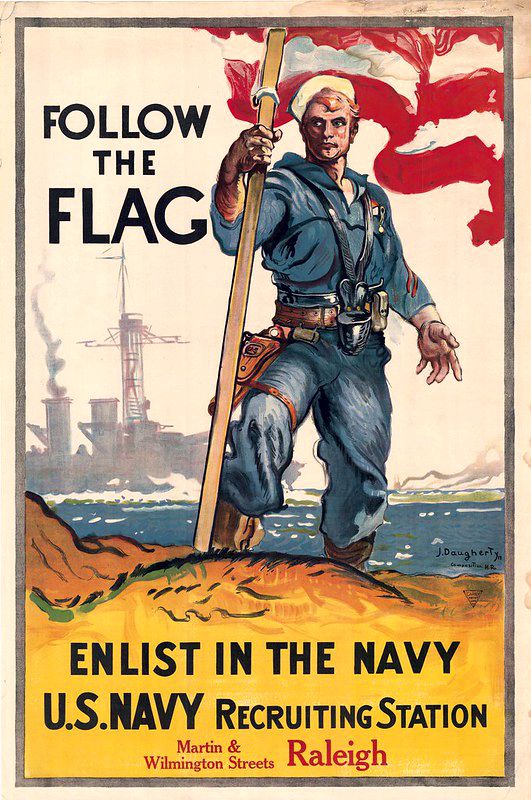The US Navy in WW1
Panoramic view of the Great Lakes Naval Training Station, Chicago, Illinois.
Because of the United States late entry into WW1, the Navy didn't directly engage the German Fleet but focused on stifling U-Boat activity in the Atlantic Ocean and the Mediterranean Sea. The Navy helped relieve the Allied forces from German attacks by sinking enemy submarines and convoyed millions of American soldiers and much-needed supplies to the war effort.
The declaration of war meant the United States Coast Guard became part of the Department of the Navy.
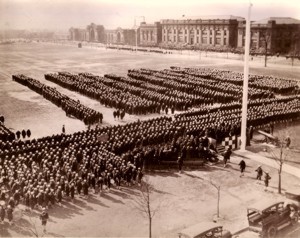
Panoramic view of the Great Lakes Naval Training Station. from the National Archives, courtesy Indiana War Memorials
The United States lost four Navy Ships during the war, only two to enemy action. Six merchant ships were lost. The greatest loss of life was the sinking of the USS Cyclops, a Proteus-class collier 542 feet long, which just disappeared in the Caribbean in March. 1918 with 309 crewmen aboard. It was the biggest ship in the Navy at that time. The last message from the Cyclops read "Weather Fair, All Well". No SOS was heard.
USS George Washington carrying President Wilson to the Peace Conference
The departure of President Wilson from New York, Dec. 3, 1918, on the steamship George Washington, formerly a German liner, on his voyage to France, to attend the Peace Conference. This event made a new record in American history, it being the first time a President has ever left the country for any length of time. A destroyer is seen escorting the President's ship down the harbor to Staten Island, where the battleship Pennsylvania assumed the chief escort duty.
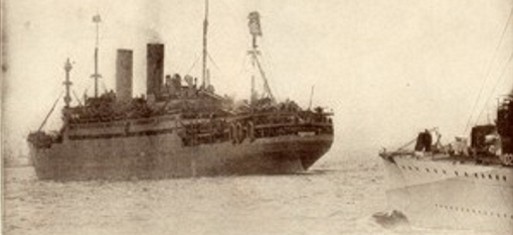
USS George Washington in 1919
US Navy photo NH 5501
America's War for the Humanities IFS photo3
A serious shortage of fuel oil from the years of warfare in Europe kept American Battleships confined to American waters during most of World War One. The Allies utilized US mine ships to help combat German U-boats. Naval guns were adapted for use on the railroad to enable them for the inland battlefields.
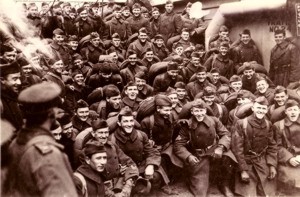
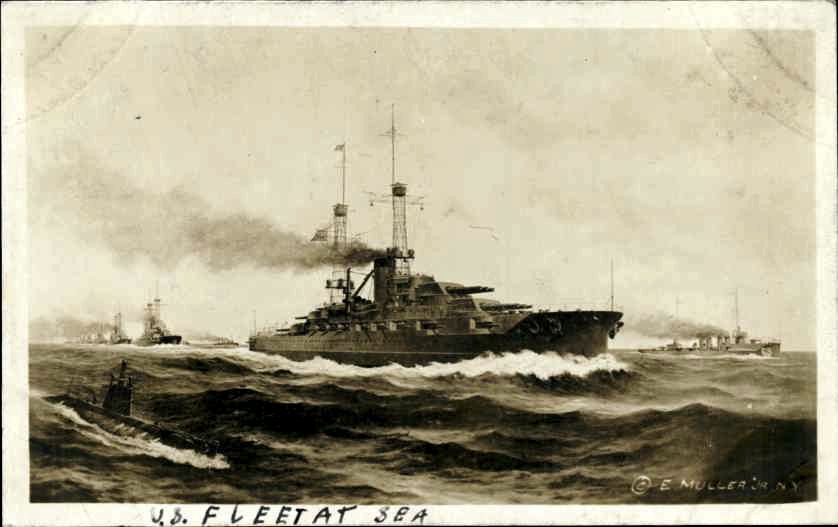
Honor Guard - Wilson's Guard of Honor on board "USS George Washington" on the return trip.
National Archives photo CN3137 IWM
Everett Jefferson Hart, USN, USS destroyer Yarnall,
Ripley County, Indiana
“Convoyed with President Wilson’s ship, USS George Washington, December 4 – 13, 1918. Transport, mail, patrol & inspections duty. Escort of George Washington, transport on President Wilson’s return to U. S. A., Feb. 15, 1919, as far as the Azores Islands. Visited airbases of German’s with inspection fleet. Convoyed with President’s ship June 29 – July 9, 1919.”
Real-photo postcard of a U.S. fleet at sea during World War I. A submarine is pictured (left).
Glenn Carlton Hiatt,
Delaware County, Indiana
Commendation, US Navy:
"...for your gallantry in jumping overboard from the Maine about 9:15 PM, October 29, 1917, and rescuing from drowning, William J. Savageau, Fireman, 3rd class. Your commanding officer reports that the night was cool and the sea rough enough to make swimming difficult and that by your prompt action you contributed greatly toward the saving of Savageau who would have otherwise have no doubt been drowned as he was unconscious when picked up."
Johnny Arthur Didway, Yeoman, U.S. Navy,
Marion County, Indiana
John Didway, son of Melville Didway and Bertha, born March 12, 1900, enlisted April 19, 1917, ten days after war was declared. Left for Great Lakes Training Station. Was there only five days when he was sent to Philadelphia and assigned to the battleship Missouri. In May, he was transferred to the transport Henderson and made his first trip in June, 1917.
The “Henderson” was with the flotilla that carried the first troops to France, always taking Marines. On the second trip they saw their first submarine, but before it could do any damage, a shot from the Charleston, another transport, blew the covering tower off and the Germans took to the water. They picked up five and took the prisoners to France, towing the sub to port where they blew it up. On the third trip over, just 7 miles from St. Nazaire, France, their flotilla was attacked by seven submarines. Two airplanes came out from shore on hearing the firing, and with their assistance, they got four out of the seven. They battled for two hours and this will go down in history as the Battle of Biscay Bay or Belle Island. The Henderson was acting as a convoy for a slow boat with the Antilles when that boat was torpedoed.
They started on their eighth trip, when 700 miles from New York, on July 3, the boat took fire. The immediately transferred their troops to another transport and started back to Philadelphia, their home port. The fire raged all the way back and for four days and five nights they fought it. The hole became so full of water that boat nearly capsized several times. The Captain told the crew that 200 should go aboard the convoy boats, leaving 150 to fight the fire. John, being the Captain's orderly, stayed with him, and they brought the boat to port July 7. He has made 11 trips to France and served as orderly until he was 18 when he took his Yeoman's exam and is now a clerk in the Captain’s office.
Nellie Hitch, Yeoman 3rd Class, USN, Gibson County, Indiana
"When Woodrow Wilson returned to the United States Navy girls in uniform at the train along with other organizations in military dress."
Jonas Howard Ingram, Lieutenant Commander, USN,
Clark County, Indiana
“Lieutenant Commander Jonas Howard Ingram is the oldest of three brothers in a family of four who chose a naval career, making a record for the family that has no equal in the history of United States Naval Academy. It had beaten all records for one family; they've also beaten the records for efficiency and competency and have been, all of them, at the head of their classes. All of them fine athletes, of fine physical development and genuine Navel modesty, of sterling American character, they have engaged the attention and elicited the regard of those who have seen them grow to manhood and their Navel careers have been watched with interest. The city of Jeffersonville is justly proud of the splendid young men in whom it is embodied as the highest type of American manhood.”
- Jonas Howard Ingram, Lieutenant Commander
- Homer L. Ingram, Senior Lieutenant, Goldstar
- William Austin Ingram, Ensign, Pacific Fleet
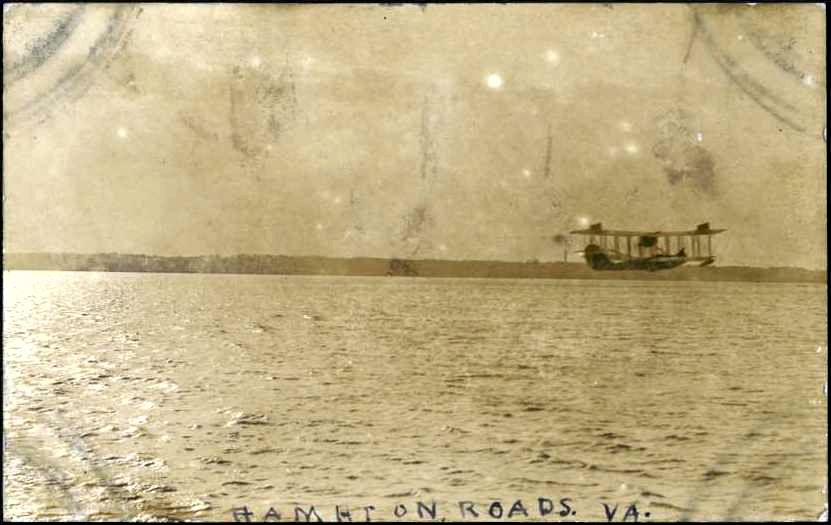
Wilbur W Linder, HMS Leinster,
Vanderburg County, Indiana
"I made the trip to London and had a fine time-saw and learned a lot. The party on that leave arrived there safely, but coming back but was torpedoed twice, the explosion being in the post office and the engine rooms. 600 people were drowned and 480 survived. One of the boys with us lost his mind and the rest of us aren't any too well balanced as a result of our experiences. Several died later. It was cold and stormy and we were crossing the Irish Sea. We were taken to Cork, where I had time to dry my clothes. I wrote you a short letter.
"The influenza was raging around here then and some died from it on shipboard. I can't figure out how it spread all over the world so quickly. It sure was terrible.
"At present, I am in the Castletown in Ireland and our ship is anchored at Bantry Bay. On the 28th of this month, we go to meet the Royal Navy. We will go with them for a while and then go back to America. The Royal Navy, or fleet, is believed to be along the Italian coast at present. I certainly want to see Italy. I have already been to England, Wales, and Ireland and now for Italy and then America."
Clarence Peter Schutz, Navy, USS Vermont,
Vanderburg County, Indiana
"During service in the Navy, our ship made a trip to Valparaiso, Chile to convoy the body of Chilean Ambassador, Don Santiago Aldunate, and to take our Ambassador, Joseph H. Shea to Chile. While on the trip we were torpedoed June 5, 1918. The torpedo struck us a glancing blow and failed to explode, so no damage was done.
"Accidentally struck my shinbone on the ship just before returning home from a furlough; lead poisoning set in on the way home and my left leg was laid up for three weeks. When I returned, I had treatments at the ship's hospital. Also had flu and relapse of mumps.
"As a sailor, I did not go front but went to sea, where our duties consisted of patrolling the high seas along the eastern coast looking for submarines.
"We would make cruises for a week to 10 days at a time, and the armistice was signed just as our ship was detailed to convoy duty."
“On first and last trips in transport duty, had three days of severe storms, one a hurricane. Advanced only 3/10 mile in four hours. Fourteen miles per hour was regular time”
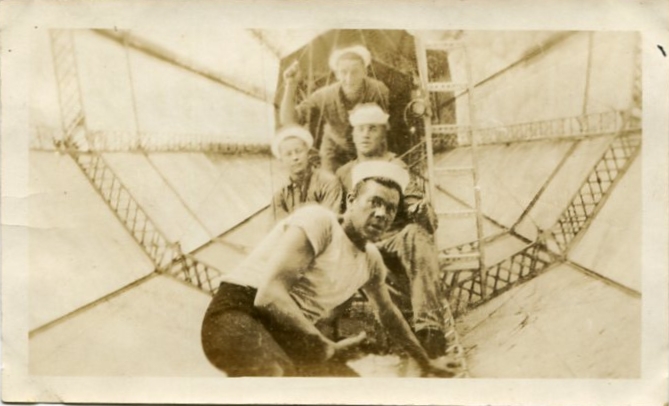
Photograph of four unidentified U.S. Navy personnel from a Naval Air Station [believed at the Naval Air Station in Hampton Roads, Virginia], shown posing inside the envelope of an airship during World War I (undated)
[Photograph taken or collected by Joseph K. Richardson].US Signal Corps photo
Photo postcard of a photograph of a U.S. Navy flying boat flying over the water at Hampton Roads, Virginia, near the U.S. Naval Station Norfolk during World War I
From Warren C. McNeill Papers, WWI 140, WWI Papers, Military Collection, State Archives of North Carolina, Raleigh, N.C.
Naval Aviation
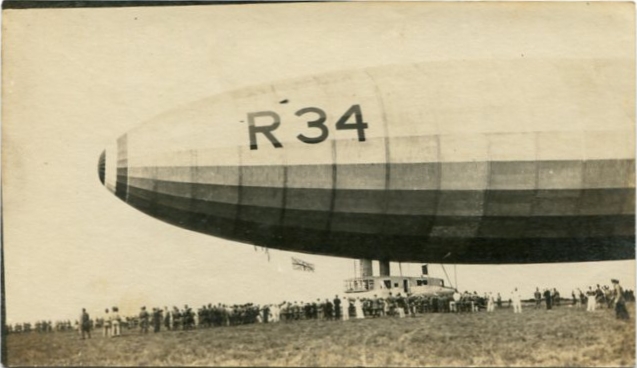
Snapshot of the nose of the British airship R34 parked on Roosevelt Field airfield near Mineola, New York, in July 1919 with a crowd of onlookers and U.S. military personnel gathered around the airship’s gondola. The R34 arrived at the airfield as it completed its transatlantic crossing from Scotland. The British flag is seen waving just in front of the gondola [July 1919] [Photograph taken or collected by Joseph K. Richardson]. US Army Signal Corps photo
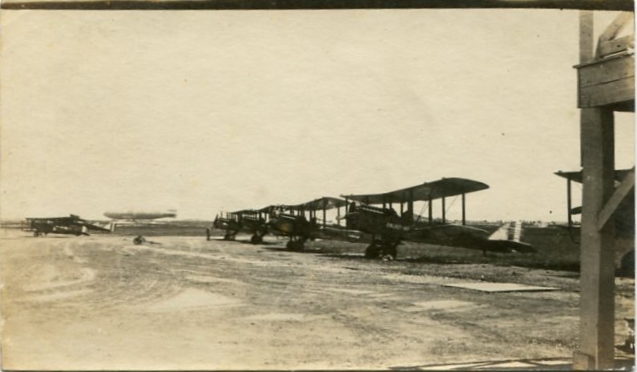
Snapshot showing U.S. military biplanes parked on Roosevelt Field airfield near Mineloa, New York, with the recently-landed British airship R34 in the background. The R34 arrived at the airfield in July 1919, as it completed its transatlantic crossing from Scotland [July 1919] [Photograph taken or collected by Joseph K. Richardson]. US Signal Corps Photo
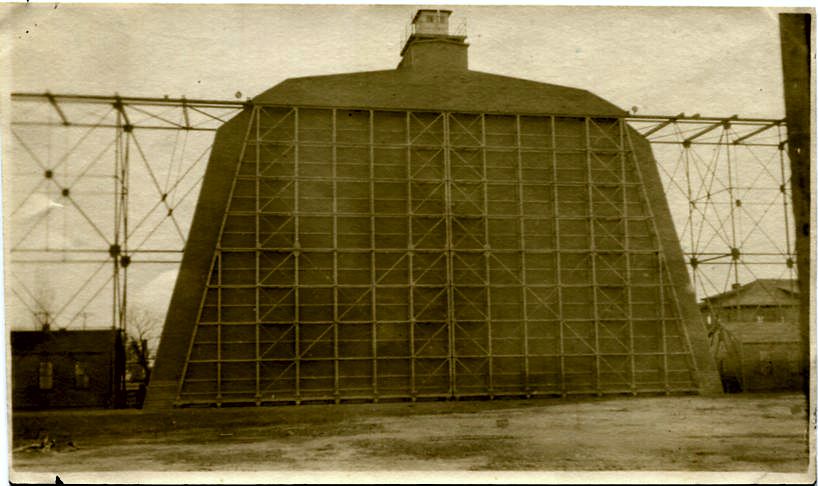
Photograph of the exterior closed doors of a U.S. Navy airship hangar at an unidentified Naval Air Station [believed to be at Hampton Roads, Virginia] during World War I (undated)
[Photograph taken or collected by Joseph K. Richardson]. US Army Signal Corps photo
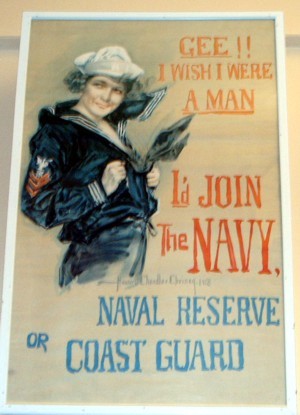
WW1 Navy recruiting poster
Indiana War Memorial Archives
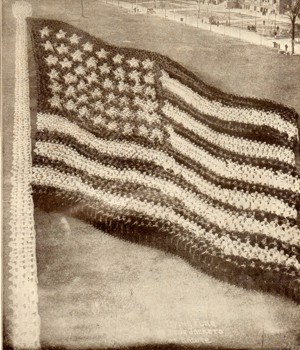
10,000 US Sailors form a living American Flag at the
Great Lakes Naval Training Station in 1917
National Archives Photo
Charles Clifford Bruner, Pharmacist Mate, 1st C, US Navy,
Decatur County, IN
“In my four years previous service (1907 – 1911) made a trip around the world with the US Fleet. Left Norfolk, Va. December 16, 1907, and arrived at Boston, October 19, 1908, covering a distance of 33,500 miles. Was on the USS Maine on the cruise and in December 1908 this battleship was sent under sealed orders to South America to go to a disturbance in Trinidad, S. A.
After spending two years in the Navy Yard Dispensary, Portsmouth, N. H., was discharged on June 23 at that place. Volunteered my services during the last war.”
Earl Seaner, US Navy,
Marion County, Indiana
USS Battleship Von Steuben.
He was the site setter on this battleship during the world war and served with the convoy of our troops to Brest, France.
On one of his trips, June 18, 1918, all was quiet aboard ship until a U-boat was sighted. Gunner Seaner was on duty at the time, about three o'clock in the afternoon, when the quick work of the gun crew saved the ship from the torpedo which missed the ship by a few feet. The ship was returning alone, without convoy, from France. Immediately firing at the U-boat and reversing the ship was due to these men's quick thinking. Gunner Seaner was given a 15-day furlough home for his quick work in firing.
The USS Von Steuben was then a German Lloyd liner, the Kronprinz Wilhelm, and put into the US harbor, Newport News to keep from being captured by the English. On August 4, 1914, she slipped from Pier at Hoboken and became a phantom ship preying on our commercial and the allied ships for eight months.
In the spring of 1915, she limped into Hampton Roads having escaped all allied pursuits and was interned here, not thinking we would enter the war. The war was declared by the United States against Germany and the United States confiscated the ship, renaming it Von Steuben.
It was put into convoy service, carrying thousands of our troops to serve against its previous country; a German crew tried to damage it and it could not be used in our service for over two years, but our Navy mechanics restored it to service in six months, the Germans thinking they would've won the war before it could be commissioned again. It served faithfully under our leadership and convoyed our troops and returning our brave boys home again. The Von Steuben is 663 furlongs, carries 1200 men, 18 guns, and is the third-largest ship in our Navy.
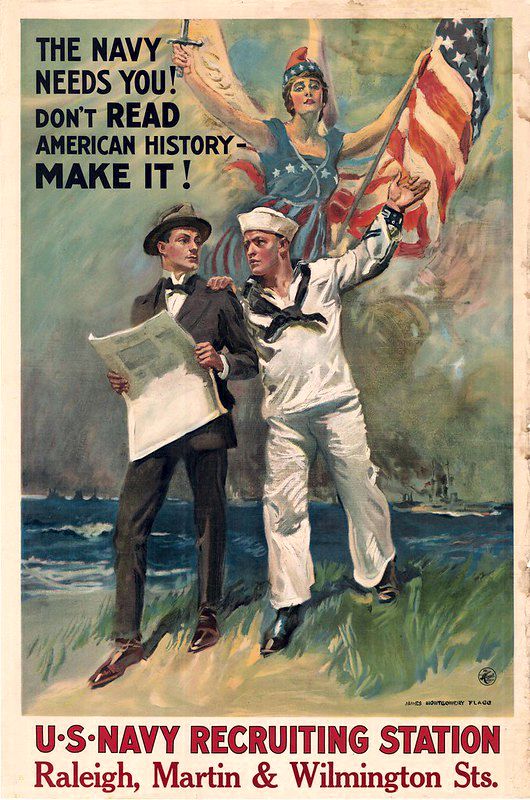
Jesse George Schmidt, Chief Quartermaster, U.S. Navy,
Vanderburg County, Indiana
“ I was attached to the Le Croisic Naval air station which patrolled and convoyed all vessels in and out of St. Nazaire, France on the Loire River. It was claimed that over a third of all the American troops landed there and more left for the USA from there after the war, and not a vessel was lost after the Americans took over the air station at Le Croisic, which was due to their alert convoy and patrol duty, as stated in a letter to the commanding officer of the station, by the French Admiral, in commendation of the sector.
Ralph William Lewis, Machinist Mate 2nd-Class, U.S. Navy,
Marion County, Indiana
"Served six-month on the Flanders front near Dunkirk.
"Attended first military ball given by the King and Queen since the fall of Napoleon. This was in January 1919 in the royal palace, the same place that was attended by Napoleon on the night of the charge by Wellington.
"Served with the supply arm of Northern Bombing Squadron, which operates with the Royal Flying Corps of Great Britain for the purpose of raiding submarine stations at Ostend and Zeebrugge.
"Made trip into Belgium with loaded guns and ammunition and passed through Ypres during the final bombardment by the Germans. This town was taken and abandoned four times the British and was captured for the last time in September 1918.
"Six weeks after my enlistment, I was in Paris, on the way to the Flanders frontier."
Harry Thomas Bruner, Boatswain’s Mate, USN, Decatur County, Indiana
“In my previous service (1908-1912), I served as a seaman aboard the gunboat USS Marietta doing coast defense duty in the tropics during the Nicaraguan uprising, later transferred to the USS South Carolina which established a record for herself in commission March 1, 1910 and April, 1910 with a green crew of 700 on the firing range Southern Drill Gion, Va. got the battleship trophy and the Naval ‘E’ which stands for efficiency. We received Ex-President Roosevelt on his return from a hunting trip in Africa; he came aboard and offered his congratulations to the men. Made the Baltic sea cruise in 19 (illegible), touching Copenhagen, Denmark; Stockholm, Sweden; Petrograd Russia; Kiel, Germany, seeing all of the crowned heads including the cause of the last of the last war ‘Kaiser Bill’”.
Lucinda Margaret Newton
Dubois County, Indiana
Navy Nurse Corps
"Armistice Day, and the joy it brought in a moment to millions of hearts. the untiring efforts to continue to meet and overcome impossibilities"
Naval Recruiting Poster, US Army Signal Corps
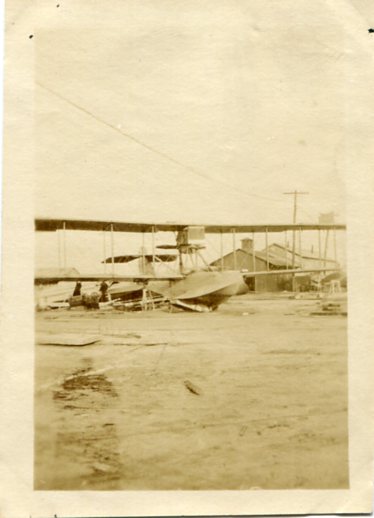
Snapshot of a U.S. Navy Curtiss HS seaplane [or “hydroplane”] parked on dry land along a shoreline at an unidentified U.S. Naval Air Station [believed taken at the Naval Air Station in Hampton Roads, Virginia] (circa 1918)
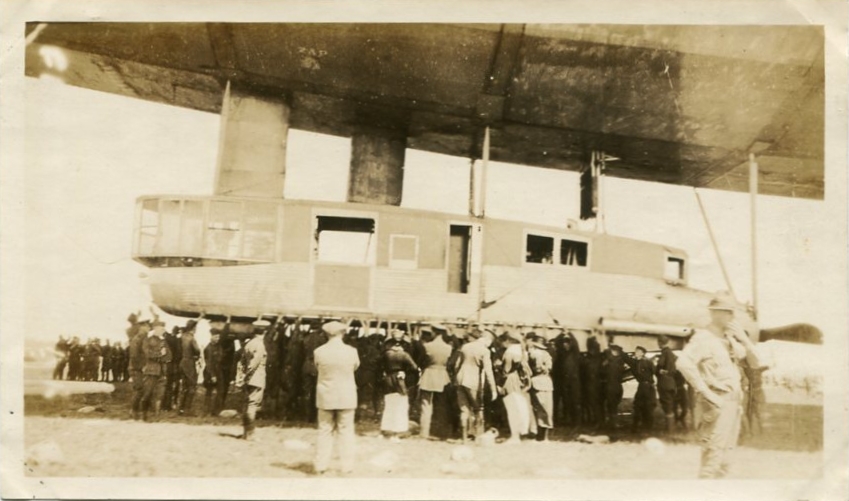
Photograph of a large number of U.S. Navy and Army personnel holding onto the bottom of the gondola of the British airship R34, while it was on Roosevelt Field airfield near Mineola, New York, in July 1919. The R34 arrived at the airfield as it completed its transatlantic crossing from Scotland [July 1919] [Photograph taken or collected by Joseph K. Richardson]. US Army Signal Corps photo
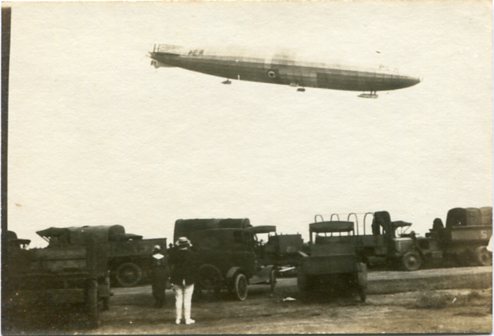
Reverse-printed photograph of the British airship R34 flying over a crowd of vehicles at Roosevelt Field airfield near Mineola, New York, in July 6, 1919, as it completed its transatlantic crossing from Scotland (circa July 6, 1919)
All three photographs taken or collected by Joseph K. Richardson] [inscription in original photo album reads “Hydroplane”].
US Signal Corps photo
Lt. Bruce Richardson Ware
Navy Cross
He was in charge of the gun crew aboard the USS Mongolia a 13 Ton passenger/Cargo liner repurposed with three 6" (150mm) deck guns for the war. The USS Mongolia was reported to have sunk a German Submarine in the English Channel. That was the first armed encounter of an American vessel in WW1.
Nations at War Photo
Lt. Ware was awarded the Navy Cross.
He was a 1907 graduate of the Naval Academy
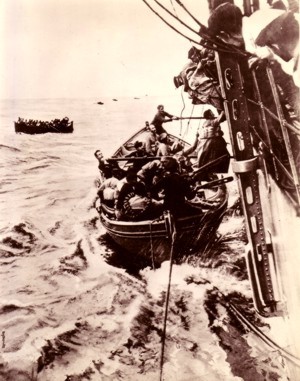
Rescued passengers from torpedoed vessel boarding French gunboat.
National Archives Photo, courtesy Indiana War Memorial
Fred Middleton, U.S. Navy,
Grant County, Indiana
Fred Middleton, son of E. C. Middleton, ran away from home when quite young, and later enlisted in the Navy. The family has not heard from him in many years, but they have reason to believe that he is still in the Navy, and was transferred to the Marine Corps for service in France.
He is one of a family of 15 children; twelve of them are still living.
William Harold Green, Seaman, USN,
Marion County, Indiana
"First voyage began October 25, 1917 - Brooklyn to Genoa, Italy as a member of armed guards on a merchant ship “Pathfinder”. Three subsequent voyages to Italy, spending 14 months in the submarine zone, service during that period being a member of a gun crew. Was shipwrecked off the coast to France on one voyage, the crew being rescued by British ship after several days and taken to Bermuda Islands, thence to the US. Spent four months aboard USS Woodcock, a ship of the “Suicide Fleet” of mine-sweepers that cleared the North Sea of mines. At present, (April 1920), on USS San Francisco near the Virgin Islands, with Fleet doing experimental work with mines."
Louis Morris Ichenhauser, Pharmacist Mate, 3c, U.S. Navy,
USS Kalk,
Vanderburg County, Indiana
"The USS Kalk (torpedo boat destroyer), on which I was stationed, was one of the convoys for the Navy trans-Atlantic flight seaplanes, the NC-4, NC-3, and NC-1. The “KALK” had station #11 with a cruising radius of 550 miles to 600 miles off the coast of Newfoundland.
"It was a clear night, with a full moon, and a calm sea running. The USS Maddox was a flagship of the destroyer division to which the USS Kalk was assigned.
"Lt. Commander N. R. VanDerveer, USN commanding Officer of the USS Kalk. Lt. Commander D. C. Hamilton, USN executive officer.
"The USS Kalk was named after Ensign Kalk, U.S. Navy who lost his life of the USS Jacob Jones was sunk by a German submarine."
“First enlisted in U.S. Navy March 7, 1908, at the Navy recruiting station in Indianapolis, Indiana. Was sent to the Naval Training Station, Norfolk, Virginia. After serving until July 1908, was sent to the USS Montana, an armored cruiser just being placed in commission, serving onboard for 3 1/2 years, during which time we traveled over 62,000 miles, as far south as Cape Town, South Africa, North as far as Denmark, and East to the Red Sea.
“In 1909, I was stationed with my ship at Mercene, Turkey during the Turkish uprising. Was sent inland from Mercene to the little town of Adaria, where 200 persons had been massacred, to assist the Hospital Corps. Was discharged from the US Naval service on March 6, 1912. Re-enlisted April 6, 1912, for four years, during which time I served aboard the USS Vermont, US tug, Alice, USS Delaware, USS Utah, USS Celtic, and the USS Salem. Was discharged from USS Salem and the Naval service on April 5, 1916.
“Reenlisted April 8, 1916, was stationed on the USS Arizona until diplomatic relations were severed with Germany, upon which time I was detailed to the Naval Recruiting Service, being in charge of substations at Quincy, Illinois, Mount Vernon, Illinois and Decatur, Illinois. Was sent as an instructor, to the Wissahickon Training Station, Cape May, New Jersey when the armistice was signed. When that station was demobilizing, I was sent to my present duty at Naval Mine Depot, Yorktown, Virginia. We are overhauling the mines and placing them in stovehouses, that were taken up along the coast of the North Sea, all my discharges were honorable.”
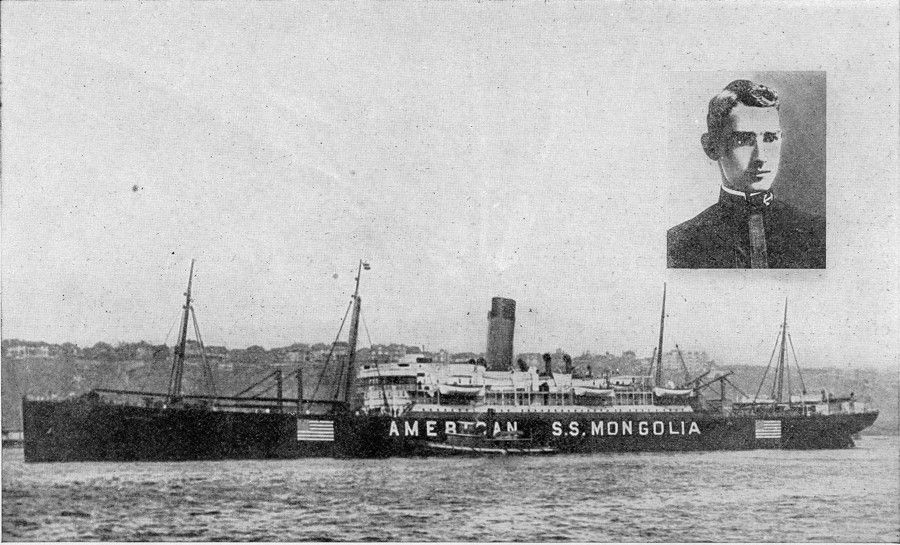
USS Mongolia
Built in 1904 as a passenger/transport liner and requisitioned by the Navy, the Mongolia served as a troop transport, completing 12 trips across the Atlantic. Each trip averaged 34 days.
Great Lakes Naval Training Station,
Chicago, Illinois
"To the mess hall"
National Archives Photo
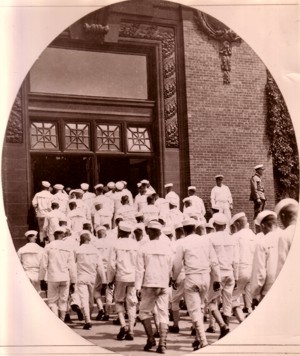
Charles Thomas Abshire,
Indiana guards & U.S. Navy
Grant County,
“I have two Indian campaigns: in 1885-8. I fought against Apaches in Arizona and Grant County, New Mexico, served in Co. E., 3rd Cavalry from Fort Davis Texas, and in 1890, I joined U.S. Navy. In 1917, I enlisted at Fort Thomas, Kentucky for the World War. I was stationed in Louisiana, Mississippi, and Alabama. I served 17 months and 15 days. Was discharged from a field hospital at Fort Leavenworth, Kansas, May 8, 1899.”
P. S. In 1885-86 I was under the name of Frank Cooper.
John Chester Stephan, Seaman, USN,
USS Mississippi, Atlantic Fleet,
Vanderburg County, Indiana
"Organized and published the "Norfolk Naval Recruit" under the permission of Captain John H. Peyton, USN, commanding. The title of the magazine was later changed to “Navy Life”.
"Assigned to operate along the coast from Portland Maine South America and Cuban waters, including the Caribbean Sea. But he was primarily cruising in preparation for an emergency call to foreign waters if German Fleet ventured to make attempt to evade the blockade."
Additional Remarks:
"The magazine I began on a mimeograph, is now operated by old shipmates of mine, namely Edwin Ford, Detroit, Michigan; Robert F. Fulton, Brookline, Massachusetts; William Avery, Seattle, Washington - present address, Norfolk, Virginia, this publication incorporated under private funds, a regular monthly publication of general interest and historical and timely pictorial features. Of great value for the public and learning something about the United States Navy.
"Evansville businessman apparently sincerely unpatriotic, according to estimates of young men who served with colors inactive branches of the service. Patently, all jobs were given to members of the Student Army Training Corps, before we, who had actually served on land and sea, were mustered out. Servicemen had to unbecomingly humiliate themselves to get jobs in Evansville. Many young men of my acquaintance left town, about the time I did, in June or July, to seek other places of business and employment. Disgusting exhibition of unpatriotic endeavor and discrimination towards young men who invaded actual military service and became attached to SATC for that purpose.
"Expressed evidence of this fact, by many young men of my acquaintance. I enlisted at 19 years of age and was not included in the draft by any means. Before enlisting, I served on the draft board in the 3rd district, voluntarily so that I might be able to get scoops for the press for which was reporting.
"THE PRESS promised me a job when I return. Did not keep the promise. Was most unfair in attitude and exhibition of interest in returning servicemen. Particularly descriptive and typical of other Evansville business interests."
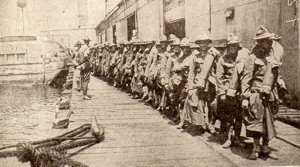
Sammies on the Way "Over There"
Troops marching along pier on their way to their transport, an Italian steamer.
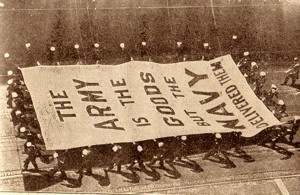
Homage to Gallant Hero's of the Sea
A mighty parade held in honor of the boys of the Navy and the Marine Corps, cities official tribute.
Freedom's Triumph, U & U
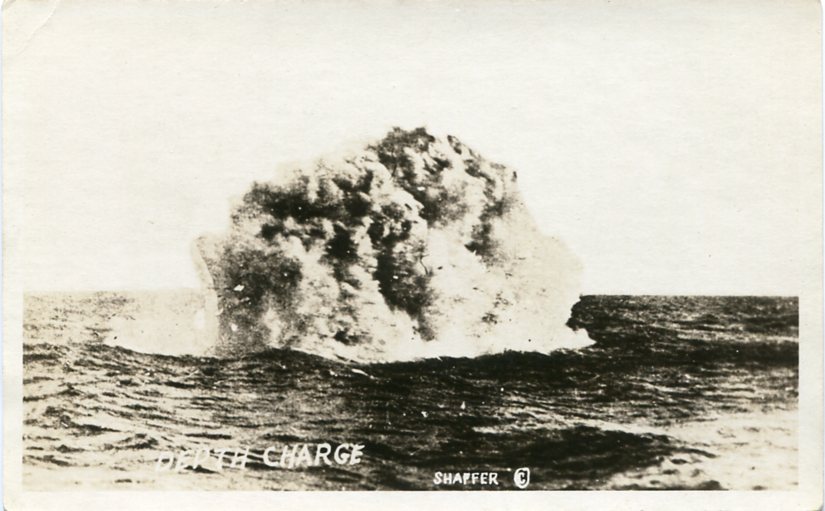
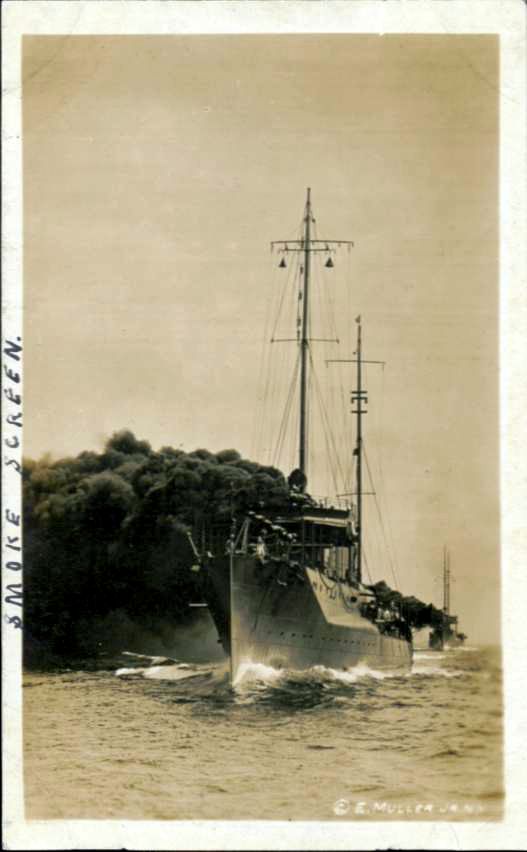
Above: Real-photo postcard of two U.S. Navy boats, with their chimneys billowing dark black smoke as a smoke screen, while at sail during World War I
From Warren C. McNeill Papers, WWI 140, WWI Papers, Military Collection, State Archives of North Carolina, Raleigh, N.C.
Left: Real-photo postcard of depth charge exploding above the surface, somewhere in the ocean during World War I (Undated) [Photograph by: Shaffer]. From Thomas C. Alston Papers, WWI 66, WWI Papers, Military Collection, State Archives of North Carolina, Raleigh, N.C.
Lester T. Lee, U.S. Navy,
USS Dizzy Quinne
Jefferson County, Indiana
“We made a barrage of mines off the Norway Coast to Scotland, with from five to eight ships abreast, each dropping a mine every five to 12 seconds. So you see they would have a little chance of getting through. Also, after the main barrage, we continued to make wings reaching out into the North Sea.
“At first it was exciting, but soon became real work; loading mines, steaming, watch the coal ship each time putting in from 300 to 550 tons of coal, and in the bunkers, the dust is so thick you had to put a handkerchief over your mouth to get your breath; you could not tell your mate working by your side, nor see electric light 10 ft. away.
“Then was time to cleaning the ship, work, and more work. Believe me, we realize we were not at home.
“Our only danger was torpedoes, German mines laid by subs in front of us, our own mines coming loosed from the anchor and floating in our path, or collisions in the fog.
“One trip, we kept going after the searchlights, burning them in daylight to keep the ship in back of us from ramming us.
"One trip, the Roanoke, the senior ship of one division, ran on a rock and two boys were killed by falling timber, some ships did not making port that night, but the Dizzy Quinn as our ship was called always was good.”
Norman Scott, US Navy,
USS Jacob Jones,
Marion County, Indiana
Graduate, US Naval Academy, Annapolis, 1910
6 years of service prior to World War I
Special Letter of Commendation
“As executive officer of the USS Jacob Jones, on the occasion of the torpedoing of the vessel on December 6, 1917, he showed marked energy and zeal and coolness and displayed excellent seamanship in getting life belts and splitter mats from the bridge into the water, and encouraging and helping the men, in general doing everything possible demanded by the emergency in the short time available. Hand-delivered, November 11, 1920, by Josephus Daniels, Secretary of the Navy
“Served on the US destroyer, Jacob Jones, which was torpedoed and sunk off the Irish Coast by a German submarine December 6, 1917. Lieutenant Scott and other survivors rescued after 23 hours in an open boat; he was later returned to the US and was assigned to service in the Bureau of Operations in Washington DC. Attended Shortridge high school, 1906”
Herbert Wattam Mills, Chief Electrician Radio,
USS Wadsworth, U.S. Navy,
Vanderburg County, Indiana
“Was with the first destroyer division to sail for Europe. One of the United States destroyers that escorted the first American troops into St. Nazaire, France in the latter part of June 1917. Served as the flagship of destroyers that took over German merchant ships at Cowes, England.
On Presidential escort three times, and one of the destroyers of the transatlantic flight of the NC-4.
George Tibbals Jarvis, Lt., U.S. Navy,
Marion County, Indiana
"The American Mining Squadron, in conjunction with the British Navy, blazed 230 miles of mines across the North Sea from the Orkney's to the coast of Norway. 700,100 mines were laid, which made up so-called North Sea Mining barrage. The American ships laid 56,570 of these mines. The field averaged 25 miles in width and nowhere less than 15 miles across. At least 17 German submarines are known to have come to grief in attempting to pass through the field. Captain Reginald R. Belknap was Commander of the fleet of 10 ships; two light cruisers and eight converted merchant craft, which made up the American mine-laying Squadron. Their base was an Inverness, Scotland, known as Base #18.
"On their mine planting “excursions” the Squadron was part of the British Grand Fleet. For protection against the submarines and raiding cruisers, it was accompanied by British destroyers, battleships or battlecruisers. These trips lasted from 40 to 80 hours. The above information is taken from reports by Captain Belknap published in the American newspapers of January 26, 1919."
Lucinda Margaret Newton,
DuBois County, Indiana
Navy Nurse Corps
"Armistice Day and the joy it brought in a moment to millions of hearts. And the untiring effort to continue to meet and overcome the possibilities."
Charles Clifford Calhoun, Navy, USS Ohio,
Hamilton County, Indiana,
Goldstar
“Charles Clifford Calhoun lived on a farm all of his life of to the time of his enlistment, he attended school at Fairy Glade and Omega, graduating from the eighth grade with high honors. He was indeed a true and trustworthy son, always ready to obey and to do his duty everywhere. His main thoughts were to care for his parents and help them to make a living, as their health was poor. He not only farmed their little farm, but he would rent the ground and do all in his power to get along. When the break between this country and Germany came, he became interested in the great conflict and announced his willingness to serve his country, in any capacity where they might need him.
He enlisted in the U.S. Navy as a sailor on November 26, 1917, left his home, and went to the Great Lakes Training Station; thereby asserting his desire to be of value to his country in time of need. It took a brave and noble boy to leave his home and loved ones as our Darling Charles did. He was greatly devoted to his mother and said to a friend before he left “It would be hard to part with mother.” but he felt it was his duty to offer his service and he left our little family, father, mother, and one brother. Charlie was a young man of excellent character and enjoyed a great circle of friends and acquaintances. Our hearts were stricken with grief when we receive the sad news of his sickness, and then in a few hours, came the sad message of death. God has taken our Charlie home to rest from sorrow and care. His soul is at rest and when our time comes to go to the Place unknown to us, may we meet him there in that heaven of rest. Sad was the call of him so dearly loved by all; his memory is as dear today as the hour he passed away. We miss his coming footsteps, we miss him everywhere. Home has lost its greatest sunshine since our Charlie has gone away.
He left the Great Lakes on December 18, 1917, and went to Norfolk Virginia, and from there to the Training Station where he was transferred to the battleship Ohio and served as a fireman until February 2, 1918, then was sent to Boston and died on February 16, 1918. We have never received any information from the hospital of his sickness, though anxiously waiting and hoping to hear.”
W. J. and Mary Calhoun, Parents, Atlanta, Indiana
Phillip Asher Millett, Chief Gunner’s Mate, U.S. Navy,
Vanderburg County, Indiana
Performed temporary duty in 1917 as a member of the armed guard on a neutral merchant ship. Transferred from USS New York, September 21, 1917, to armed guard, receiving ship, Brooklyn, New York. Made one trip to Genoa Italy as a member of the US armed guard crew. Returned to New York on November 2, 1917, and transferred to the USS Mars, a supply ship, carrying cargo for the Army. Was at Halifax during the explosion, December 7, 1917, and did rescue work there.
Ernest Haycock , Navy,
Jefferson County, Indiana
"I've been to Wakefield, Massachusetts at the Naval rifle range, had a great time there and good luck also. I qualified as an expert rifleman, which is higher than a sharpshooter on the expert team. After I had qualified and made a record on the range of getting 19 Staples size. A bull's-eye counts five and four out of 20 shots at 500 yd. They gave me a score of 99 out of a possible 100 and we had issued 20 shots in change position fire.
"In change position, you have a check of five shells and get ready. Then the target is up five seconds and out of site five seconds, and in the meantime, you have to shoot, throw a new shell into your gun and change position, viz., this first shot prone, second kneeling, third squatting, for standing, and the fifth prone again, and go over that four times to get the 20 shots. I got 91 out of that, which gave me out of score in the end. Match of 190 out of a possible 200. The highest ever made on their range before was 187, by Marine, a year ago.
"Altogether I made $8.50 and prizes. One dollar and the marksman scores, two dollars on the sharpshooter scores, three dollars on expert riflemen course, one dollar, on an expert team match, $1.50 getting the highest score on the machine gun."
Van Buren Jarvis, Ensign, U.S. Navy, USS Aylwin, destroyer
Service on Sea: Destroyer duty on the coast of England. The USS Aylwin carried the most improved type of depth bombs and listening devices.
Cecil George Cooley, Ensign, U.S. Navy
Traveled more than 18,000 miles while on USS Arkansas, and was in Cuba, Trinidad, England, France, and the Panamá Canal zone. In England on trans-Atlantic flight duty, brought Admiral Benson home from peace conference and 26 Army officers. Went to West Coast with Pacific Fleet, July 14 to August 7. Left ship in Los Angeles on the evening of August 13, 1919.
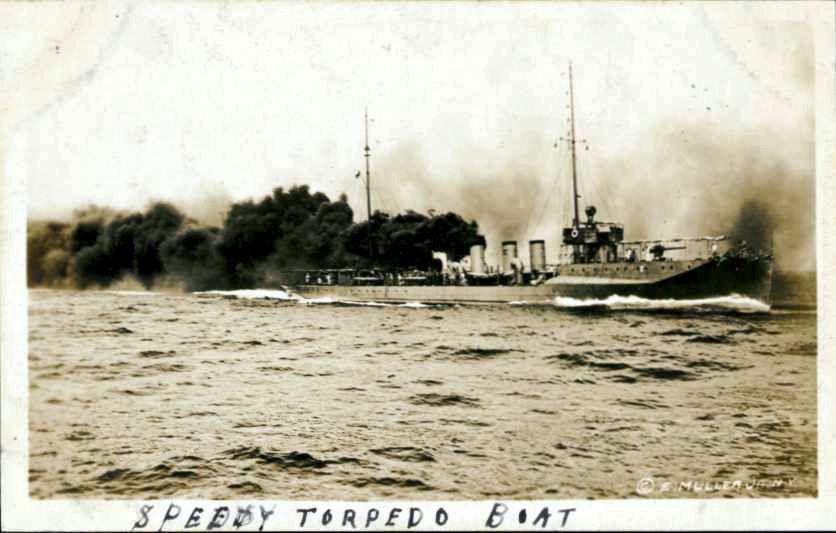
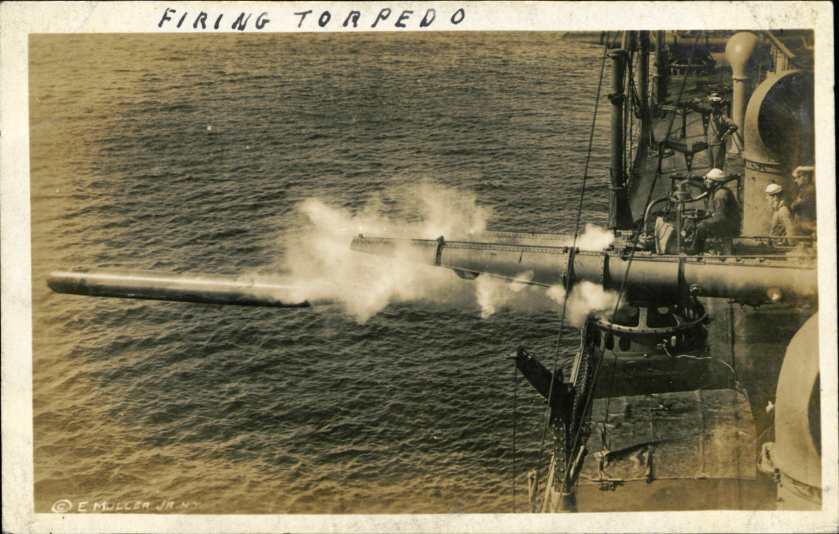
Real-photo postcard of a U.S. Navy torpedo boat at full speed, with its chimney billowing dark black smoke, while at sail during World War I. Photograph taken
From Warren C. McNeill Papers, WWI 140, WWI Papers, Military Collection, State Archives of North Carolina, Raleigh, N.C.
Real-photo postcard of an unidentified U.S. Navy torpedo boat firing a torpedo from the deck of the ship while at sail during World War I.
From Warren C. McNeill Papers, WWI 140, WWI Papers, Military Collection, State Archives of North Carolina, Raleigh, N.C.
Postcard provided by the Navy Dept to honor Seaman Murray's service.
Photos provided by Joseph Faulkner
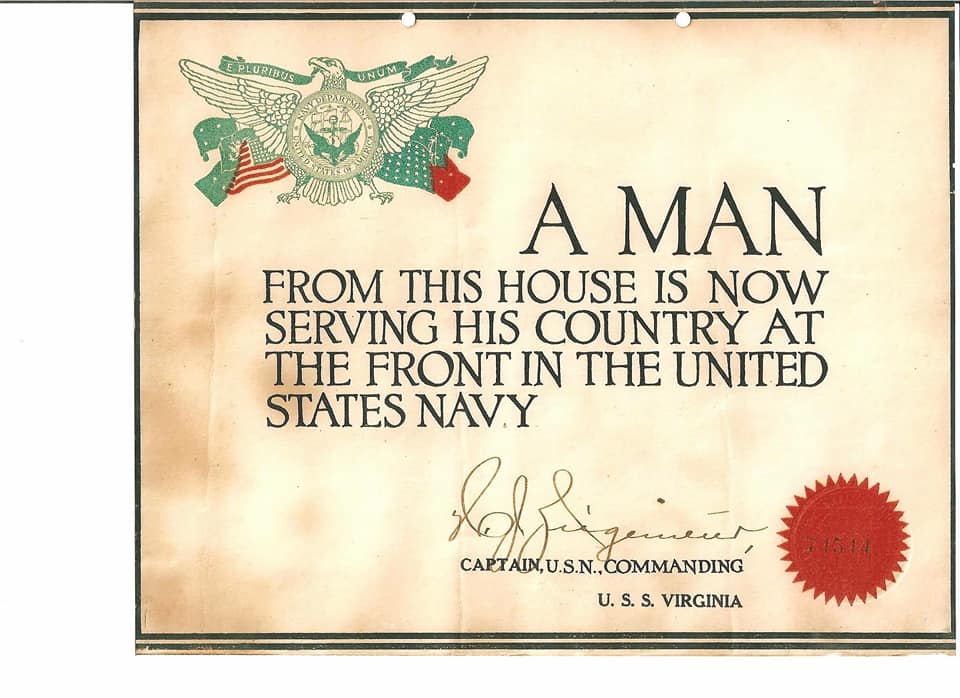
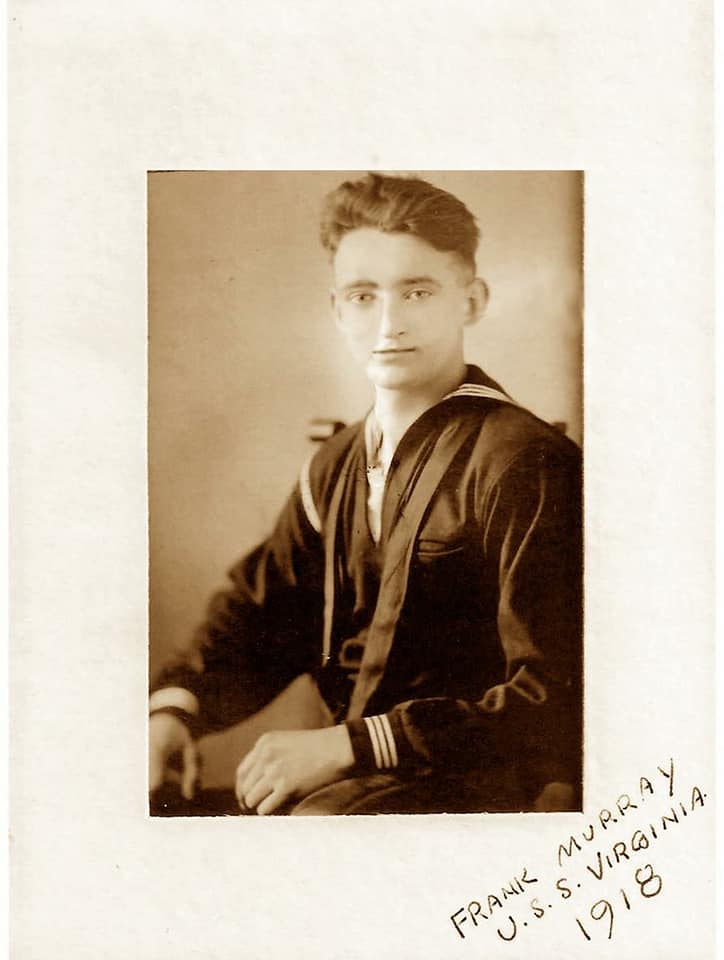
Women in Naval Service:
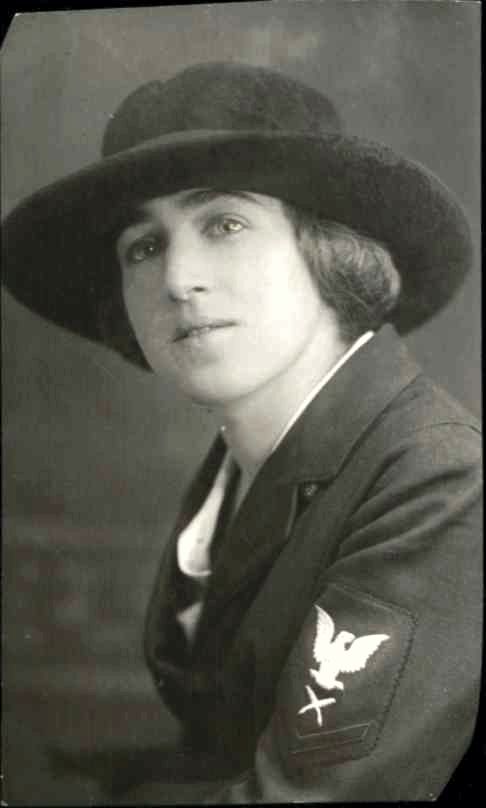
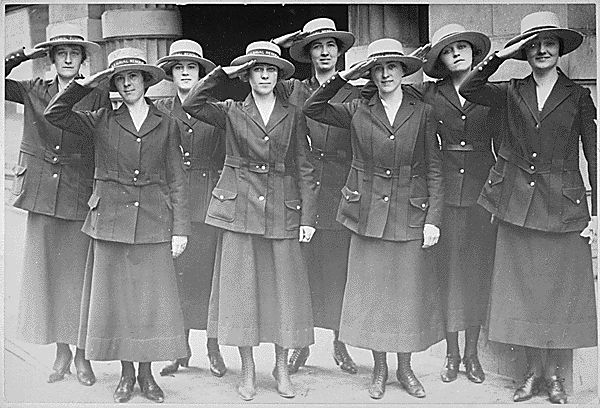
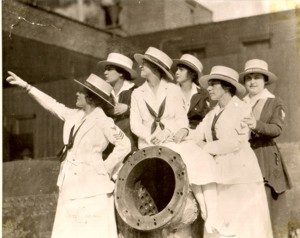
1. Real-photo postcard of a studio portrait of an unidentified U.S. Navy female Yeoman (F), wearing a dark-colored hat and her uniform, taken during World War I.
2, Photograph of San Francisco Yeomen Attached to the Naval Reserve;
3. WW1 Yeowomen, Bush Terminal, Brooklyn, NY
National Archives Photos
Alvin Dora Thompson, Navy, USS Mercy, Hospital Ship, Huntington County, Indiana
“Most recruits coming under my observations seem to have had no previous discipline, training, or any idea of teamwork, all of which are necessary in any organization. The idea could very easily be instilled during school and get away from any system of compulsory military training in after years.”
USS Mercy, first completely equipped hospital ship.
The operating room of the "USS Mercy"
National Archives Photo CN2989 Group 63,
Indiana War Memorial
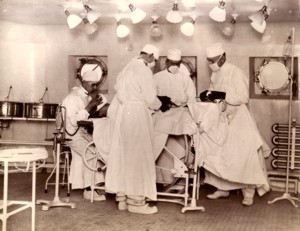
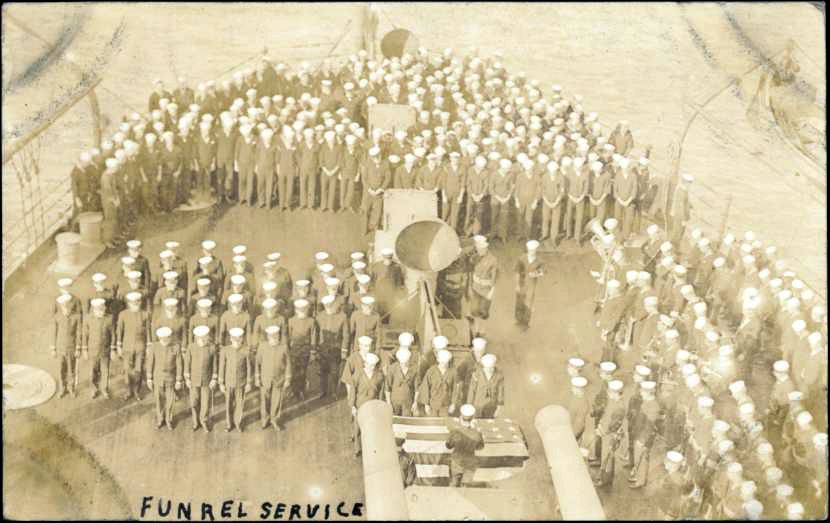
Burial at Sea
Photograph taken looking down from above on the deck of the battleship USS Louisiana (BB-19), as a funeral is being performed aboard deck during World War I
All photos from Warren C. McNeill Papers, WWI 140, WWI Papers, Military Collection, State Archives of North Carolina, Raleigh, N.C.
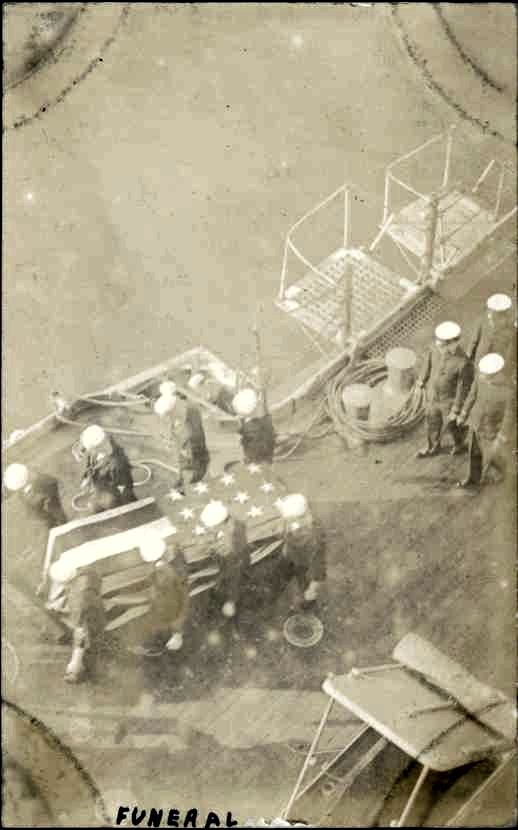
U.S. Navy personnel on the deck of the battleship USS Louisiana (BB-19), carrying a coffin draped in an American flag on the deck of the ship, bringing it to be lifted down onto a wooden boat to be carried off for a funeral during World War 1
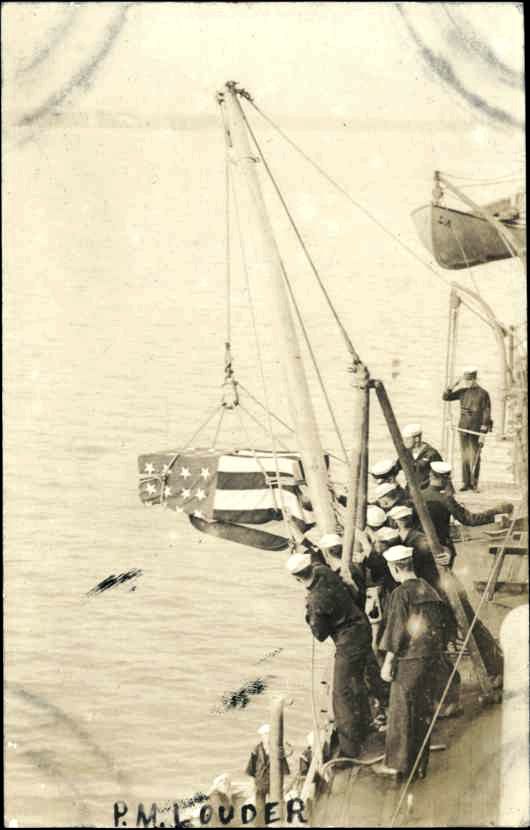
U.S. Navy personnel on the deck of the battleship USS Louisiana (BB-19), lowering down an American flag-draped coffin by a cable lift from the ship’s deck, to a wooden boat below to be carried off for a funeral during World War I.
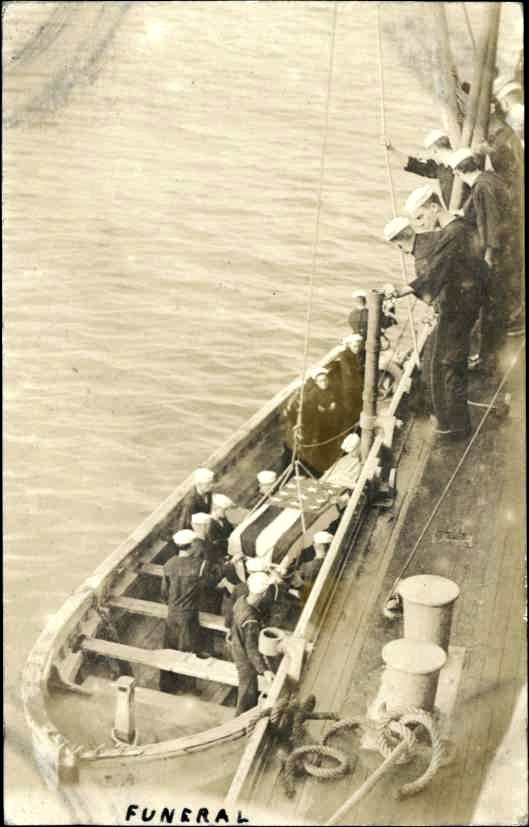
U.S. Navy personnel on a wooden boat guiding an American flag-draped coffin down onto the boat as it was being lowered down by a cable lift from the deck of the battleship USS Louisiana (BB-19) to be carried off for a funeral during World War I
Ruth Ellen Jordan,
Army Nurse Corps,
Knox County, Indiana
"One morning before landing in Liverpool, we were attacked by a submarine, a torpedo fired at us, then to the small steamer, and do to the quick action of our Capt. in changing course of the ship, it passed us without harm. Spent Easter Sunday, 1919 in Brittany, marveling at the quaint customs.
John Henry Davis, Warrant Officer, U.S. Navy,
Marion County, Indiana
"Transferred to San Francisco from Detroit, August 20, 1917. From there went to USS Venetia (a converted yacht) around through the Panamá Canal to New York. From there to Philadelphia and back again to New York, from where he started, by way of Bermuda and the Azores and on to the submarine zone in the Mediterranean. He touched on the Italian, North African, French, and coast of Gibraltar during the 10 months, active service. Saw some real war during that time. Exactly one year from the first transfer on August 20, 1919, was transferred to land duty. Went to London and traveled a bit through England and into Cardiff, Wales at the US Naval Station there. He has been there for five months at the present location. Office of the Disbursing Officer, US Naval Base, Cardiff, Wales."
Statement of service of John Henry Davis, U.S. Navy, during the war against Central European powers.
"On duty at the US Navy Recruiting Station, Detroit, Michigan at the time the declaration of war (April 6, 1917). Remained on this duty throughout the recruiting campaign, then volunteered for general service in August 1917. Rating - Chief Yeoman, USN.
"On August 20, 1917, was transferred from Detroit to San Francisco, California, and on August 31, 1917, again transferred to the Navy Yard, Mare Island, Vallejo, California for duty in connection with converting the yacht Venetia into a Man o’ war for foreign duty. Sailed from Mare Island on October 23, 1917, for Philadelphia, Pennsylvania via Panamá Canal. Arrived at Philadelphia, November 14, 1917. Worked between Philadelphia and New York City (on Venetia) in connection with a fleet of submarine chasers until December 20, 1917, on which date sailed from Philadelphia as a unit of 3rd Detachment, US Naval Expeditionary Forces, for duty in the war zone, via Bermuda and Ponta Delgada, Azores. This detachment consisted of three yachts (converted), five ocean-going tugs, and 10 submarine chasers.
"The trip was made to Bermuda without incident, but from there to the Azores, stormy weather, the most severe and enduring ever experienced by any of the members of the crews, was witnessed; so after twelve most trying days, the detachment began straggling, one at a time, into port. From Pontia Delgado the detachment made way to the coast of Portugal, were at the port of Oporto, the Venetia, with two of the tugs and three chasers steamed to Gibraltar, the remainder of the detachment had gone to Brest, France. The Venetia Division arrived at Gibraltar on February 21, 1918, and was immediately assigned to duty as Mediterranean convoy Escort, making two trips each month from Gibraltar to Bizerta, Tunis, (North Africa) and return or to Genoa, Italy and return. Remained on this duty until August 20, 1918, during which numerous submarine attacks and battles were encountered.
"On January 23, 1918, was promoted to the temporary rank of Acting Pay Clerk and worked at this capacity on the Venetia until August 20, 1918, when I was detached from the yacht and ordered to London England for further orders, which orders, when received, were to proceed to Cardiff, Wales, for duty in the US Naval disbursing office, which was to be opened at this place. Arrived here on September 5, 1918, and have been continuously on this duty since that date.
"Note: he has been promoted from Chief Petty Officer to Warrant Rank and has worked in the office abroad of Admiral Linus and Lieutenant Commander Ingram."
Picture postcard of a view of the U.S. Navy cruiser ship the North Carolina (ACR-12), at sale during the 1910s [circa 1910s] [Postcard by: Hugh C. Leighton Company, Portland, Maine].
Maurice C. Riley, US Navy,
Marion County, Indiana
"Served onboard the USS Hartford, USS Oklahoma, USS Kearsarge, USS Pocahontas and the USS Westgate. Made seven trips to France and returning on the USS Pocahontas, four trips to Brest, France, three trips to St. Nazaire, assisted in transporting 40,000 soldiers to France and covering over 45,000 miles on the Atlantic Ocean.
"Transferred October 1 to the USS Westgate, when, 900 miles from shore, on the Atlantic, was sunk at 2:30 a.m. the morning of October 7. After many hours of suffering in icy waters, he was rescued by the steamer, American, and taken to Halifax, Nova Scotia.
The USS Westgate had a 3 million-dollar cargo, airplanes, due for France. 17 lives were lost. He was discharged honorably January 14, 1919, and is an employee of the Indianapolis News."
Tilford Irving Harding, USN,
USS DeKalb,
Ripley County, Indiana
“The DeKalb was once the German raider, ‘Prince Eitel Frederick’
“The DeKalb carried 413 soldiers from the fronts, 25 Marines also from the fronts, 54 officers and 657 sailors. The transport encountered on this trip, ‘the worst storm the ship had ever gone through.’ Every man aboard, from Capt. Dodd and Capt. Alger down to the hardiest deck-swabber aboard, all agreed on that verdict. 54 degrees was a common angle for the DeKalb to take when the going was at its worst. Dr. Judy and his assistant surgeon and orderlies clawed their way up and down among the injured men, helping to get the armless and legless soldiers back into their bunks from which the crazy lurchings of the ship had dumped the wounded men.
“One wave smashed a deck-house in and the next one slammed what was left of it overboard. Lifeboats were stove in, funnels were bent until they looked as though someone had poured too much of ‘the hard stuff’ into them. One private remarked: ‘The old pond beat up this boat like it knew she was once a d-m German’”
Peter Karbowski , USN,
USS Worden, destroyer class,
Ripley County, Indiana
“The Worden picked up survivors from a coal-ship sunk between Brest and Lapalise, France by a submarine. The submarine dived under the Worden, scraping the bottom of the destroyer in doing so. The Worden gave chase and fired five depth charges. They watched half a day but saw only oil on the water to indicate the submarine’s fate.”
Four Brothers Now in Service,
June 6 Newspaper Clipping,
Decatur County Historical Records, Indiana State Library
Mr. and Mrs. James Maudlin, of the city, have made the supreme sacrifice in the war. Four sons are now the war service, two in the Army and two in the Navy. Alva Maudlin, the eldest, has been in the service for nearly seven years and is stationed in the Philippines. Charles Maudlin 18, enlisted about two weeks ago in the Army, is stationed at Jefferson Barracks, Missouri, William and Albert, 21 and 17, respectively, are in the Navy. William is in the transport service.
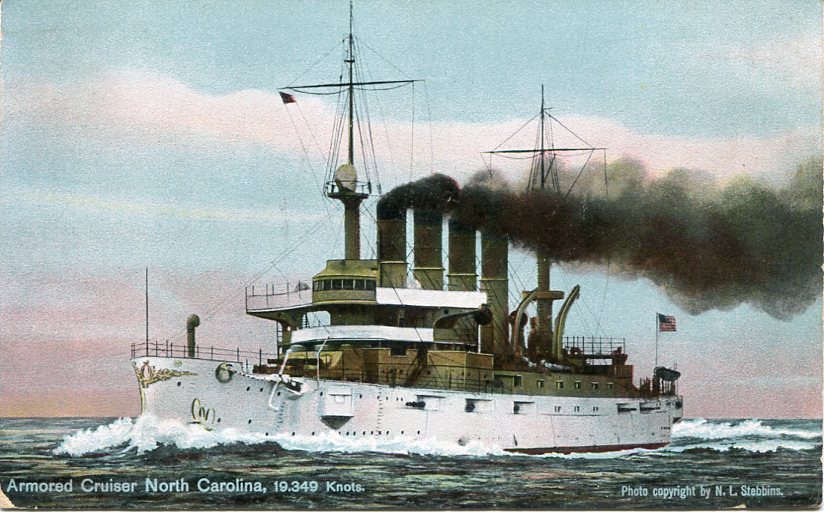
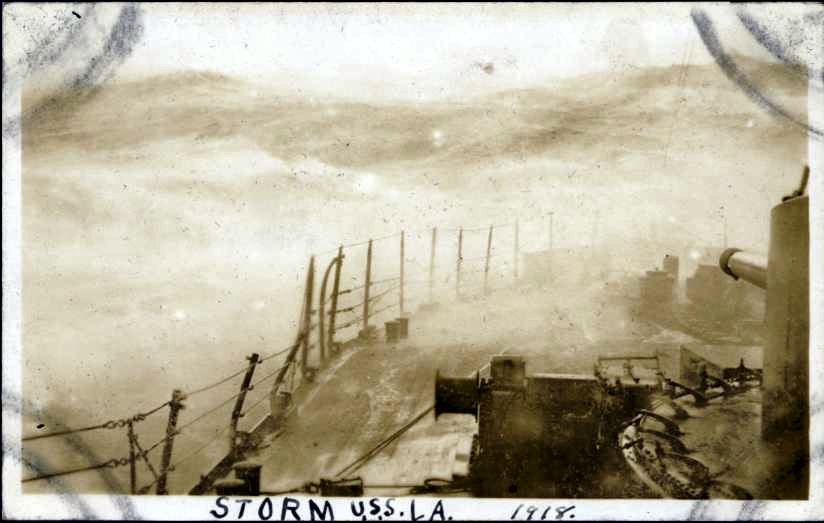
Storm at Sea
Real-photo postcard of a photograph looking out over the bow of the battleship USS Louisiana (BB-19) at a storm while at sail during World War I in 1918. The large waves are seen about the crash next to the ship.
US Army Signal Corps photo
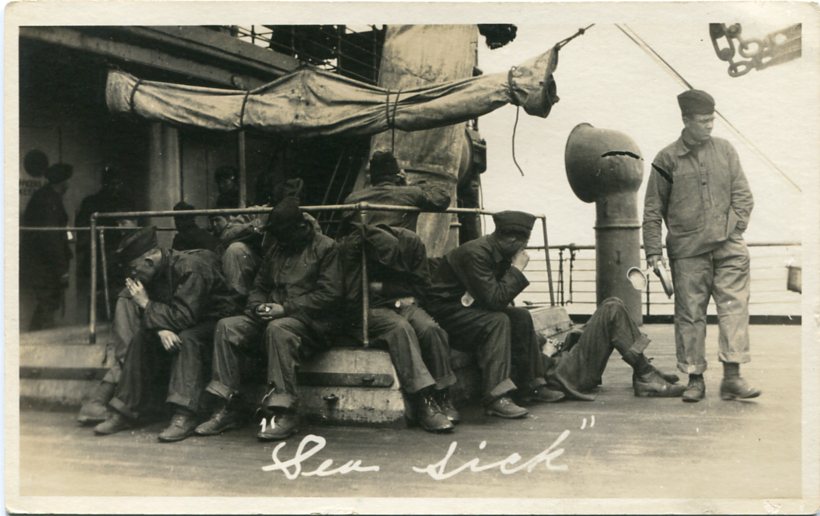
Seasick sailors
Real-photo postcard of U.S. soldiers huddled on the deck of the USS Powhatan (ID–3013), a U.S. Navy troop transport ship, suffering from sea sickness while the ship was at sea during World War I (Undated)
US Army Signal Corps Photo
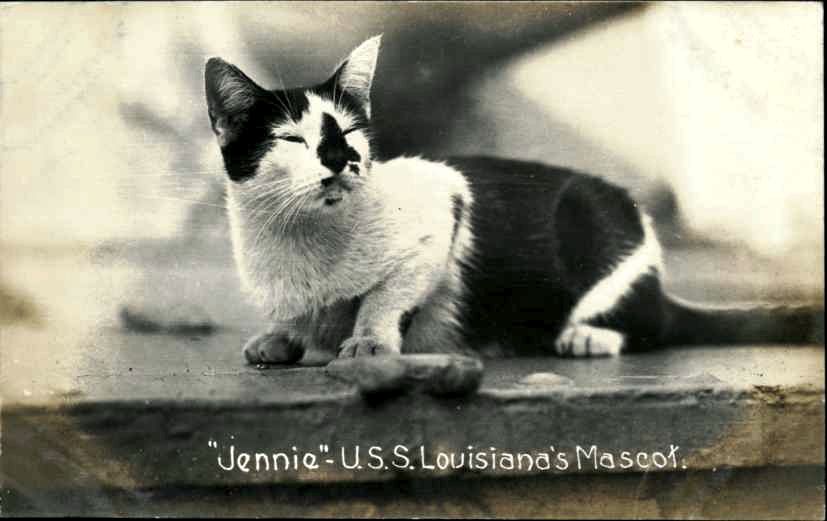
Jennie
Real-photo postcard of a photograph of a cat named Jennie on the battleship USS Louisiana (BB-19). Jennie was the Louisiana’s mascot.
US Army SIgnal Corps Photo
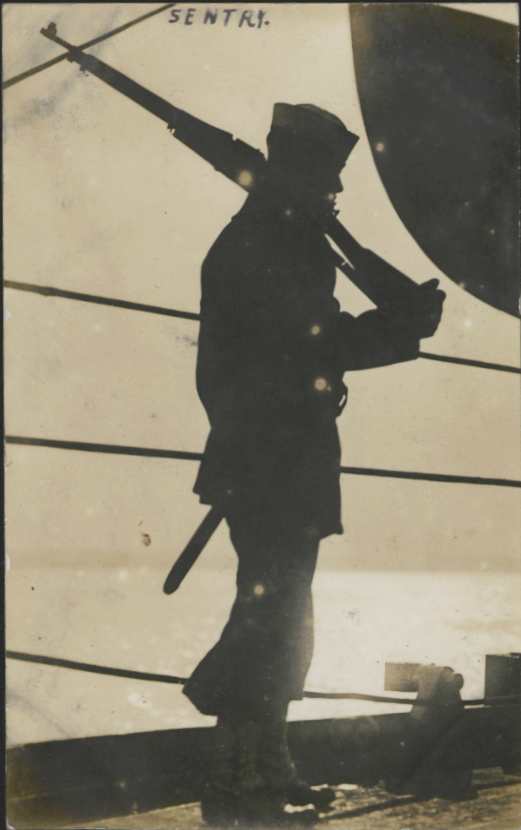
Real-photo postcard of a photograph of a U.S. Navy sentry on the deck of the battleship USS Louisiana (BB-19), silhouetted by the sun shining in the background, during World War I. The outline of part of a rowboat is seen in the photograph.
From Warren C. McNeill Papers, WWI 140, WWI Papers, Military Collection, State Archives of North Carolina, Raleigh, N.C.
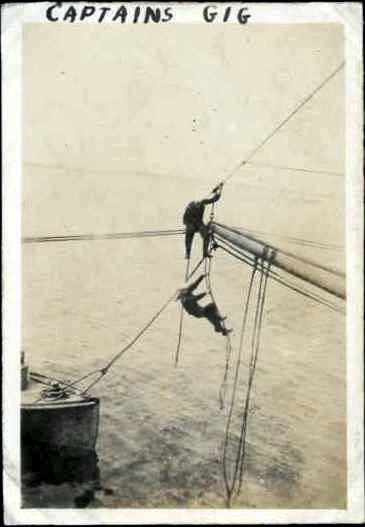
Snapshot of two unidentified U.S. Navy sailors climbing up a rope ladder on the rigging hanging over the water from the battleship USS Louisiana (BB-19), with a smaller boat pictured tied off to the rigging, during World War I.
From Warren C. McNeill Papers, WWI 140, WWI Papers, Military Collection, State Archives of North Carolina, Raleigh, N.C.
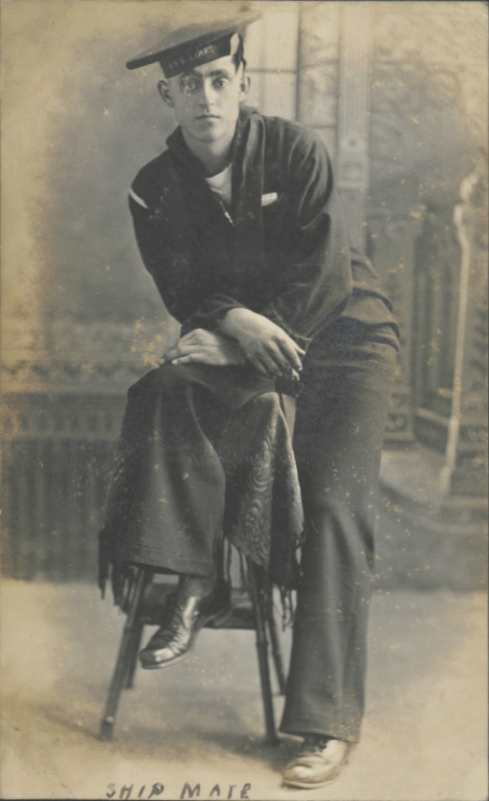
Postcard of a studio portrait of U.S. Navy sailor John Delisle, wearing his Navy uniform and flat cap, with one of his legs resting on a stool.
US Army Signal Corps Photo
USS Covington
The first big ship lost in the war zone while under American Convoy. USA transport "Covington" shown here sinking fast with colors flying.
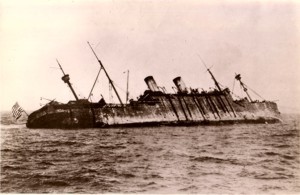
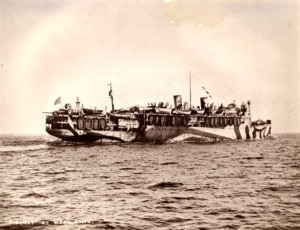
USS Siboney in camouflage coat.
Both photos from National Archives, courtesy Indiana War Memorial
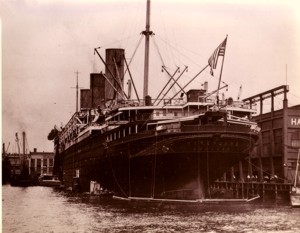
Germany's greatest liner, seized by the US now flies the Stars & Stripes. SS Vaterland, now the USS Leviathan flying the American flag from the mast at her stern.
(All Leviathan photos from the National Archives, courtesy Indiana War Memorial)
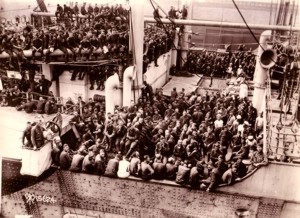
56th Reg., Infantry, 7th Division, boarding the USS Leviathan.
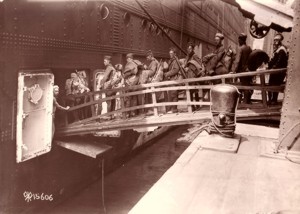
Troops arriving in New York boarding the USS Leviathan
Your content goes here. Edit or remove this text inline or in the module Content settings. You can also style every aspect of this content in the module Design settings and even apply custom CSS to this text in the module Advanced settings.
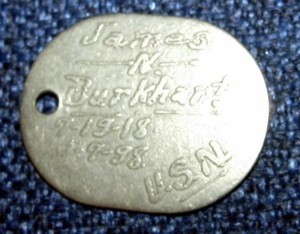
WW1 Navy Dog tag
IWM Collections
Dog tags were not standard issue until 1913. (Civil War soldiers would pin paper identification on themselves prior to going into battle.)
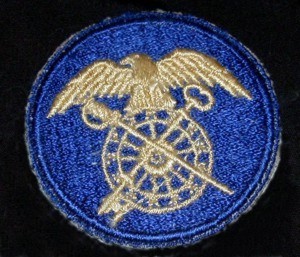
WW1 Quartermaster Patch
Indiana War Memorial Archive Collections
US Navy Recruiting Poster
US Army Signal Corps Photo
